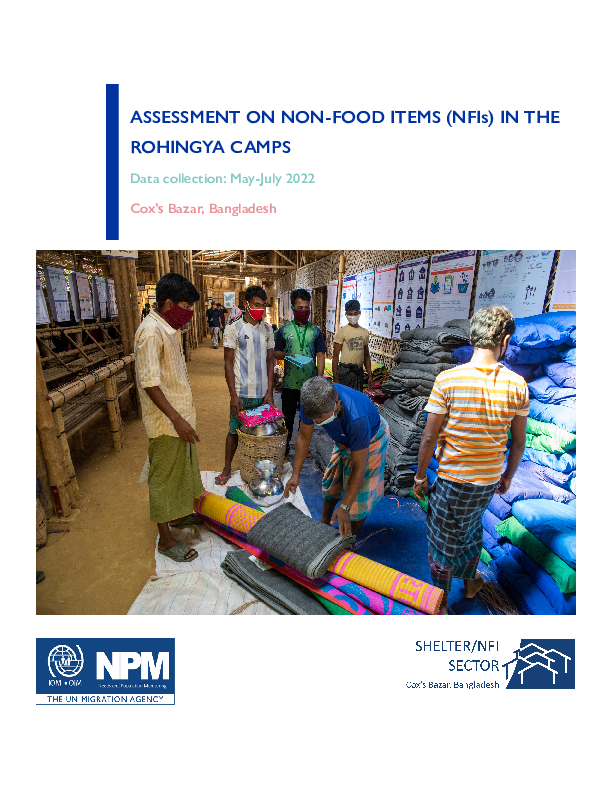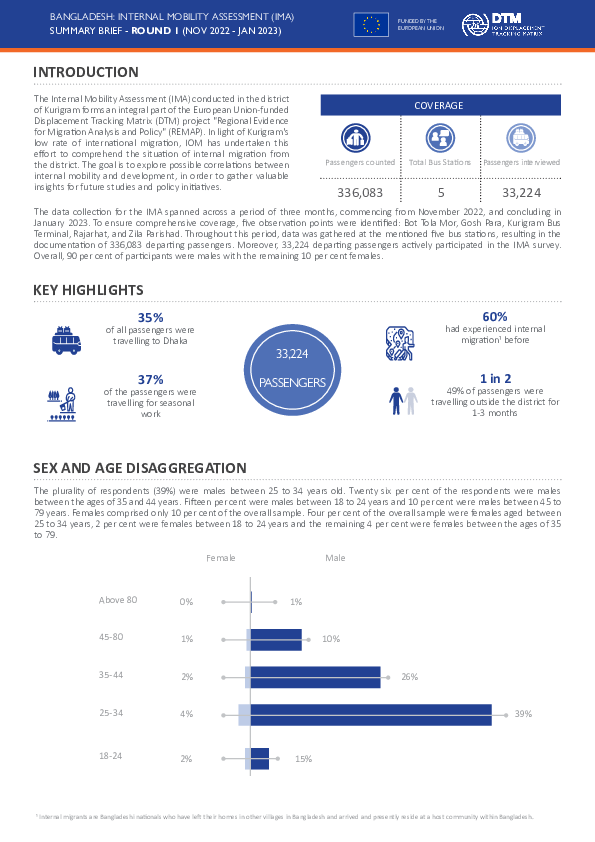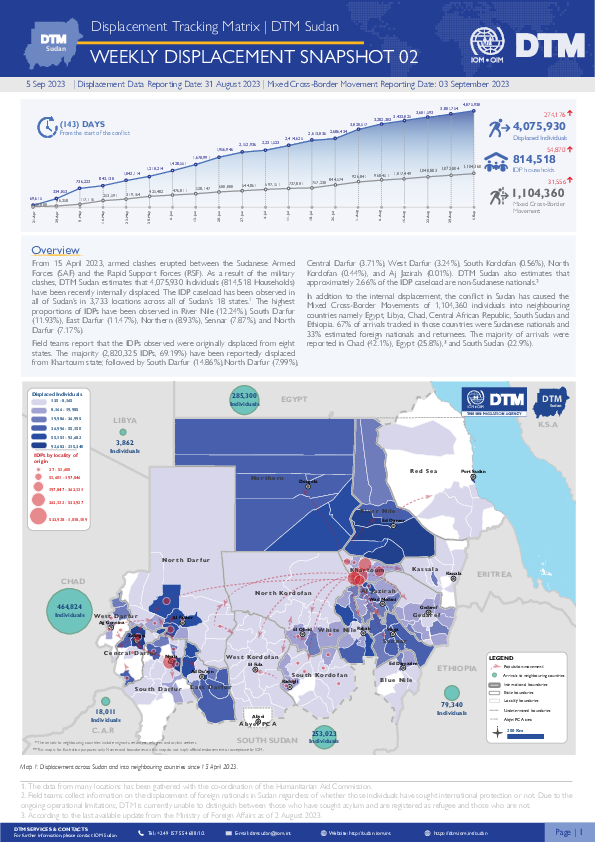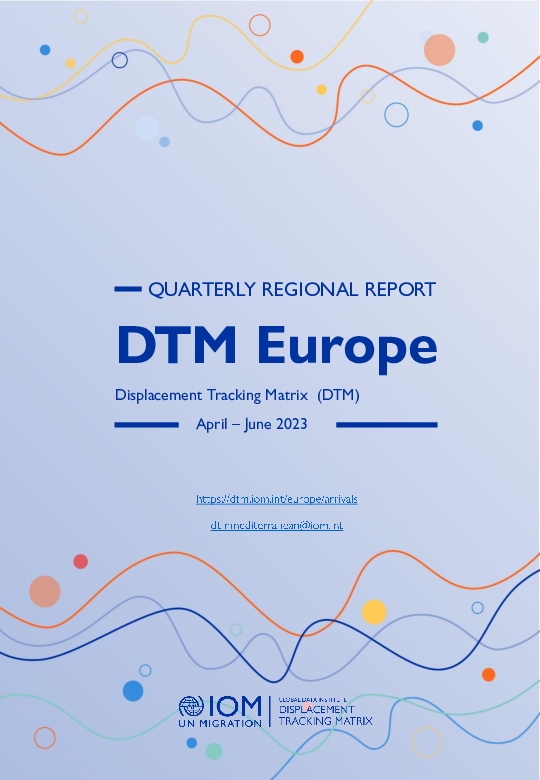-
Countries
-
Data and Analysis
-
Special Focus
-
Crisis Responses
Assessment Report

Contact
DTM Mozambique, DTMMozambique@iom.int
Language
English
Location
Mozambique
Period Covered
Jul 12 2023
Aug 04 2023
Activity
- Mobility Tracking
- Baseline Assessment
This summary presents findings of the 19th round of Mobility Tracking Assessments (previously known as Baseline Assessments) conducted across Northern and Central Mozambique through key-informant assessments and group interviews at location level between July and August 2023. Mobility Tracking assessments estimate the presence of internally displaced persons (IDPs) and returnees across Mozambique. IOM DTM mapped a total of 850,599 IDPs and 571,468 returnees in 325 locations. Overall increase on the number of IDPs and Returnees is attributable to the widened coverage. Comparing with previous assessments which covered only Northern Mozambique, the July-August 2023 assessment was widened to cover Manica, Sofala, Tete and Zambezia provinces.

Contact
NPM Bangladesh, npmbangladesh@iom.int
Language
English
Location
Bangladesh
Period Covered
May 01 2022
Jun 30 2022
Activity
- Survey
- Community Perception
Following the devastating flash floods in May and June 2022 in the districts of Sylhet and Sunamganj, the Displacement Management Cluster, Gender Based Violence (GBV) Cluster, Shelter Cluster and Education Cluster collaborated to assess the flood evacuation centres through partners currently active in the affected areas. Information was collected on the situation in the centres during the flood, the present conditions of the centre and the challenges. In Bangladesh, evacuation centres are known as cyclone centres and/or flood shelters (depending on the geographical location) where displaced people take shelter during disasters, and they are usually multifunctional. Support for the assessment was provided by the IOM Needs and Population Monitoring (NPM) team who has expertise in data collection and information management through FGDs with KIs (Key Informants)

Contact
NPM Bangladesh, npmbangladesh@iom.int
Language
English
Location
Bangladesh
Period Covered
Feb 01 2022
Jul 30 2022
Activity
- Survey
- Community Perception
Rohingyar Hobor (Rohingya news) is a regular trends report produced by IOM Needs and Population Monitoring (NPM), IOM’s Protection Unit (Research and Consultations team), and ACAPS. Its objective is to better explain the Rohingya’s wellbeing in the camps and their perception and recounting of recent events that affect their lives. These reports draw upon qualitative and quantitative data collected from 20 different sub-blocks across Kutupalong Balukhali Expansion as part of a longitudinal research exploring welfare through the Rohingya’s access to assistance, economic conditions, and relationships within the response. No data was collected in Teknaf for any rounds because all Rohingya researchers and enumerators live in Kutupalong Balukhali Expansion, and movement restrictions prevent them from travelling to Teknaf to conduct consultations. The first report in this series was published in May 2021, and a total of four rounds have been completed so far Topics identified in the last round as important to the Rohingya were the market demolitions in the camps, educational needs of children, emerging skin diseases, increased feelings of insecurity, stress among the population, and relocation to Bhasan Char. In round 4, topics discussed included the limited social connectedness within communities, increased negative coping strategies, and the need to pay money to be considered for a job in the camps.

Contact
NPM Bangladesh, npmbangladesh@iom.int
Language
English
Location
Bangladesh
Period Covered
May 01 2021
Jun 30 2022
Activity
- Survey
- Community Perception
It has been five years since Rohingya refugees fled from Myanmar to Bangladesh, however the humanitarian response still remains focused on meeting humanitarian needs. A number of humanitarian agencies are supporting them by providing their basic needs and Non-Food Items (NFIs) are one of core necessities of people. The needs for NFIs are expected to continue as the access to income generating activities and livelihood opportunities are still limited for refugees. Considering their needs Shelter/NFI Sector together with NPM conducted a survey to understand people’s opinions on the needs of Non-food Items (NFIs) and information on their existing NFIs. NFIs are non-food items. This assessment focused only on the NFIs that are coordinated by the Shelter/NFI sector (houseware, cooking ware, etc). The assessment did not cover WASH items like jerry cans and buckets.
Contact
DTM Libya, DTMLibya@iom.int
Language
English
Location
Libya
Snapshot Date
Aug 31 2023
Activity
- Mobility Tracking
- Site Assessment
Detention Centre Profiling is a component of IOM Libya’s Displacement Matrix programme. It is a data oriented tool that routinely provides specific sex and age demographic data and key sectorial information on individuals held in Libya’s detention centres on the date of assessment.

Contact
DTM REMAP Support Team (dtmremapsupport@iom.int); DTM REMAP Bangladesh Team (remapbd@iom.int)
Language
English
Location
Bangladesh
Period Covered
Nov 17 2022
Jan 16 2023
Activity
- Survey
- Mobility Tracking
The Internal Mobility Assessment (IMA) conducted in the district of Kurigram forms an integral part of the European Union-funded Displacement Tracking Matrix (DTM) project "Regional Evidence for Migration Analysis and Policy" (REMAP). In light of Kurigram's low rate of international migration, IOM has undertaken this effort to comprehend the situation of internal migration from the district. The goal is to explore possible correlations between internal mobility and development, in order to gather valuable insights for future studies and policy initiatives.

Contact
DTM REMAP Support Team (dtmremapsupport@iom.int); DTM REMAP Bangladesh Team (remapbd@iom.int)
Language
English
Location
Bangladesh
Period Covered
May 12 2022
Jun 08 2022
Activity
- Mobility Tracking
- Baseline Assessment
As the COVID-19 pandemic emerged globally, migrant workers, both internationally and within Bangladesh, found themselves facing a new set of challenges and vulnerabilities. With limited access to income-generating activities, social services, healthcare systems, and social support networks, many have opted to return home. Two years after the first cases of COVID-19 emerged in Bangladesh, the impacts of the pandemic continue to be felt in the country, albeit in smaller waves. During May and June 2022, IOM conducted a third round of data collection, supported by the European Union under the regional program REMAP and in coordination with the Research and Policy unit of the Ministry of Expatriates’ Welfare and Overseas Employment, Bangladesh, along with the NPM team based in Cox’s Bazar, to further enhance the understanding of economic impacts and relevant challenges related to COVID-19 in Bangladesh while focusing on a longitudinal perspective and analysis.

Contact
DTM Niger, DTMNiger@iom.int
Language
English
Location
Niger
Period Covered
Aug 01 2023
Aug 15 2023
Activity
- Flow Monitoring
L’OIM, à travers l’outil de suivi des flux de populations (Flow Monitoring en anglais) de la Matrice de suivi des déplacements (Displacement Tracking Matrix, DTM en anglais), récolte des données à des points d’entrée, de sortie et de transit clés afin de mieux comprendre les mouvements de populations à travers l’Afrique de l’Ouest et du Centre. Le suivi des flux de population est une activité qui permet de quantifier et de qualifier les flux et tendances de mobilités, les profils des migrants, et les expériences et routes migratoires. Ce rapport est fait à base des données collectées du 1 er au 15 août 2023.

Contact
DTM Sudan, DTMSudan@iom.int
Language
English
Location
Sudan
Snapshot Date
Aug 31 2023
Activity
- Mobility Tracking
- Baseline Assessment
Overview
From 15 April 2023, armed clashes erupted between the Sudanese Armed Forces (SAF) and the Rapid Support Forces (RSF) in multiple cities across Sudan. Clashes initially took place in cities across Northern and Khartoum states, later spreading across the Darfur and Kordofan regions.
Highlights
- DTM Sudan estimates that 4,075,930 Individuals (814,518 households) have been recently internally displaced.
- The IDP caseload has been observed in 3,733 locations across all of Sudan’s 18 states.
- The highest proportions of IDPs have been observed in River Nile (12.24%), South Darfur (11.93%), East Darfur (11.47%), Northern (8.93%), Sennar (7.87%), and North Darfur (7.17%).
- Field teams report that the IDPs observed were originally displaced from eight states. The majority (2,820,325 IDPs, 69.19%) have been reportedly displaced from Khartoum state; followed by South Darfur (14.86%), North Darfur (7.99%), Central Darfur (3.71%), West Darfur (3.24%), South Kordofan (0.56%), North Kordofan (0.44%), and Aj Jazirah (0.01%).
- DTM also reports the Mixed Cross-Border Movements of 1,104,360 individuals into neighbouring countries.
DTM Europe gathers, validates and disseminates information on migrants and refugees travelling through the Mediterranean, Western African Atlantic, and Western Balkan routes to Europe. Key routes include:
- Eastern Mediterranean route (EMR): Bulgaria, Cyprus and Greece
- Central Mediterranean route (CMR): Italy and Malta
- Western Mediterranean route (WMR): Peninsular Coasts of Spain, Balearic Islands, Ceuta and Melilla
- Western African Atlantic route (WAAR): Canary Islands of Spain
DTM also monitors data on migrants in transit through the Western Balkans (WB) region (Albania, Bosnia and Herzegovina, Croatia, Montenegro, North Macedonia, Serbia, Slovenia, Romania, and Kosovo*). These are considered separately to prevent to the extent possible the double counting of the same persons that cross multiple borders to reach Central Europe.
This report presents the latest available data and trends, focusing on the first two quarters of 2023:
- Mixed Migration Flows to Europe
- Migrant Flows Monitoring in the Republic of Türkiye
- First Arrival countries (Italy, Greece, Spain) and other countries of first arrival (Bulgaria, Cyprus and Malta)
- Transits through the Western Balkan region
- Migrants' presence, in Europe and the Republic of Türkiye
Pagination
- Previous page
- Page 78
- Next page

